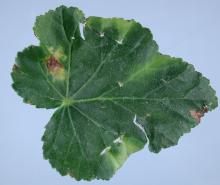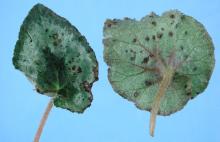Cause Xanthomonas axonopodis pv. begoniae, a bacterium. Can survive in dead leaves at least 1 year and is favored by splashing water, overhead irrigation, and temperatures from 80°F to 90°F. The bacteria can enter injured roots or leaves and may not produce symptoms for weeks. Bacteria can also enter the leaf through hydathodes at the leaf margin. They can be spread through recycled irrigation water or handling of plants. Different groups, species and hybrids show different susceptibility. Rex and tuberous begonias are less severely infected than Rieger begonias. Rieger begonias can become systemically infected. The common bedding plant Begonia semperflorens has low susceptibility while the hardy begonia (B. grandis) develops spots and marginal scorch symptoms.
Symptoms Water-soaked circular lesions surrounded by yellow halos develop on leaves. Leaf spots are small and somewhat transparent. They enlarge and run together, causing a blotched appearance. Bacteria ooze from the infection, then dry and turn light brown. Symptoms can vary depending on the cultivar. Spots or blotches may be V-shaped, confined between major veins, or small, round, and purple. Leaves fall early and, in severe cases, stems are invaded and the entire plant wilts and dies. Systemically infected Rieger begonias wilt and die.
Cultural control A strict sanitation program is essential to manage this disease.
- Propagate cuttings from healthy plants, and use sterilized soil or media with a pH of 5.5 to 5.8, a temperature of 72°F to 75°F, and a calcium-to-magnesium ratio of 2:1.
- Isolate new cutting or plug shipments for an observation period to be sure they are not diseased. Locate the isolation area away from existing blocks or outgoing shipments.
- Osmocote was shown to be helpful to limit disease development. Higher rates resulted in less disease but higher fertilizer damage.
- In the greenhouse, increase ventilation and reduce humidity.
- Space plants adequately for aeration.
- Eliminate overhead watering.
- Workers should wash their hands frequently when handling plants, and tools should be disinfected as well.
- Remove all diseased plant parts. Rieger begonias must be tossed away completely.
- Apply water to soil or media only.
Chemical control Focus heavily on cultural control methods first. Sprays may reduce the rate of foliar infections but are ineffective once the bacteria are systemic in the plant. Copper phytotoxicity (such as marginal leaf burn) may depend on cultivar. Use on a few plants and observe in 7 to 10 days for symptoms of phytotoxicity.
- Badge X2 at 1.5 to 2 lb/A. Group M1 fungicide. 48-hr reentry general or 24-hr reentry for greenhouse. O
- Bonide Copper Fungicide at 8 oz/3 gal water. Group M1 fungicide. H
- CuPRO 5000 at 1.5 to 2 lb/A. Group M1 fungicide 48-hr reentry.
- Grotto at 1.5 to 5.9 fl oz/2.3 gal water/1,000 sq ft. Group M1 fungicide. 4-hr reentry.
- Junction at 1.5 lb/100 gal water. Group M1 + M3 fungicide. 48-hr reentry.
- Kalmor at 0.5 to 2 lb/100 gal water. Group M1 fungicide. 24-hr reentry. O
- KleenGrow at 6 to 38 fl oz/100 gal water. Greenhouse use only. 48-hr reentry.
- Monterey Liqui-Cop at 3 Tbsp/gal water. Group M1 fungicide. H
- Nu-Cop 50 DF at 1 lb/100 gal. Group M1 fungicide. 24-hr reentry.
- Phyton 27 at 1.5 to 3 fl oz/10 gal water. Group M1 fungicide. 48-hr reentry.
Reference Ornek, H., Aysan, Y., Mirik, M., and Sahin, F. 2007. First report of bacterial leaf spot caused by Xanthomonas axonopodis pv. begoniae, on begonia in Turkey. Plant Pathology 56:347-347.


